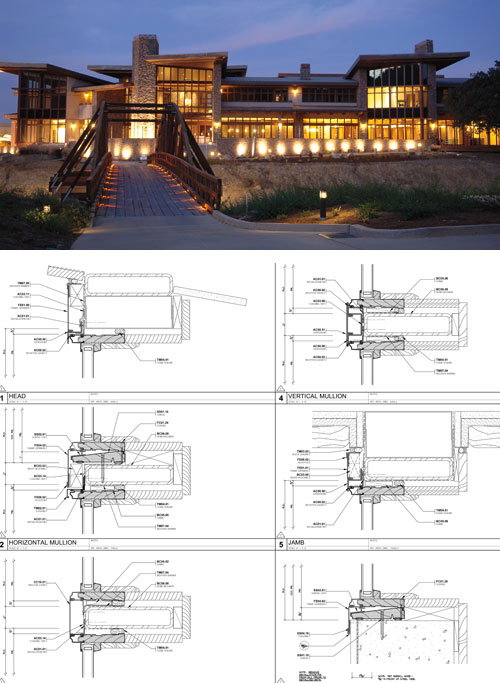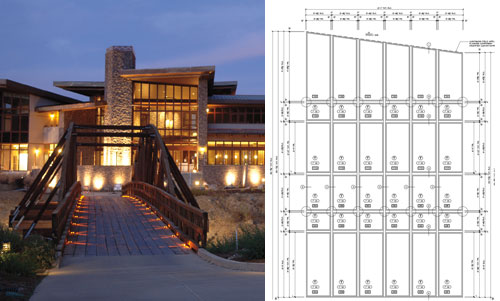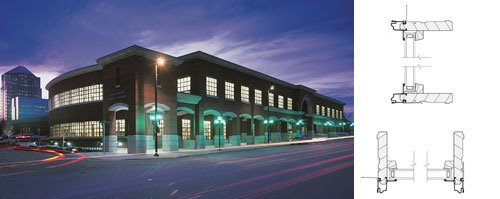Window and Fenestration Systems Selection
Beyond direct thermal transfer through materials, codes and standards, along with the NFRC, have increasingly recognized air infiltration as a very significant factor in fenestration performance. Therefore, it is becoming required for all residential fenestration systems to meet minimum standards for air infiltration and be tested, certified and labeled as such. Energy Codes also look at other overall performance characteristics including the well-established solar heat gain coefficient (SHGC) which measures how much heat passes through a particular glazing. This is usually adjusted by coatings applied to the glass to allow more light (and resulting solar heat) where it may be desired in cold climates, or to allow less where it is not wanted in hot climates. Green building standards assign value to visible light transmittance (VLT) for daylighting so finding the right balance between how much solar heat is brought in versus how much to exclude needs to be looked at on a project-by-project basis.
The ultimate balancing activity in any design is how much fenestration to use as a percentage of the overall wall area of a building. The energy codes tend to use 40% as the benchmark. Building designs with higher percentages are possible but offsetting measures elsewhere in the building envelope are required. The rationale for this benchmark seems to rely on the fact that a well-insulated wall will inherently perform better thermally than any type of fenestration. Nonetheless they also recognize that only fenestration allows the natural daylight and potentially beneficial solar heat gain into buildings. Simple energy modeling of different scenarios during the earliest stages of design will help to determine the most appropriate balance of opaque wall to fenestration. This is particularly important when different façade orientations (i.e. north, south, east, west) are taken into account since the best performing buildings usually do not treat all facades equally. The talent, experience and skill of the architect used in finding this appropriate balance will determine not only design quality and code compliance, but in a very real way the overall energy performance and utility costs experienced by the owner and users of the building.
Beyond energy performance of fenestration, they need to address other environmental concerns as well. The total system must be able to withstand wind pressures associated with their location. Water penetration cannot occur which means that water must either be sealed out completely or managed so that if it does penetrate a part of the system, it will drain away harmlessly. Air infiltration must be similarly controlled not only for energy performance as discussed, but for occupant comfort and long-term durability of the fenestration system.
With all of the above in mind, we will explore below the fundamental choices available to architects and others in fenestration types. These include 1) pre-glazed windows manufactured out of different frame materials, 2) aluminum storefront systems, and 3) aluminum curtain wall systems.
PRE-GLAZED MANUFACTURED WINDOW UNITS
 |
Clad Wood Window Walls: A window wall made up of individual aluminum-clad wood window units ganged together horizontally and vertically. Installation details showing intermediate structural members between individual aluminum-clad wood windows. Images © 2008 K. Easley |
Individually manufactured pre-glazed windows are commonly used as single units that fit into “punched openings” in the wall. While this may be quite desirable aesthetically with good thermal performance and light distribution, it is not the only choice. Ganging windows together horizontally with concealed intermediate support as required, yields the “ribbon window” look which has been popular in schools and office buildings for some time. Similarly, they can be stacked vertically to create the appearance of a large vertical opening. By combining them in both directions, with intermediate concealed support as required, a full window wall can be created. This produces the appearance of large expanses of fenestration consistent with the look of many commercial and institutional buildings. By selectively creating various sizes and shapes of ganged windows, individual pre-glazed window units can successfully be used in all types of commercial and institutional buildings, including retail storefront applications, although aluminum storefront systems are most often used.
| Clad Wood Window Walls Case Study Journey at Pechanga Golf Course Location: Temecula, CA |
||
The clubhouse at the prestigious Journey at Pechanga Golf Course was designed to be as breathtaking and unforgettable as the awe-inspiring beauty of the surrounding Temecula Valley. The Frank Lloyd Wright-inspired three-story, 62,000 square-foot building is the centerpiece of the world-class Journey course. The philosophy behind the clubhouse's design was to work with nature. The concept was brought into fruition with the use of stones indigenous to the area, the use of natural light flowing in from more than 500 individual windows, the incorporation of wood, as well as numerous fire pits and fireplaces. A cascading 30-foot waterfall is a dramatic focal point just inside the oversize lobby doors. From the large ribbon windows to the soaring three-story window walls, aluminum-clad wood windows play a major role in the clubhouse's aesthetic impact. Their custom-color aluminum-clad wood exteriors and stained alder interiors enhance the other natural construction materials, allowing the building to beautifully reflect its majestic landscape. The window manufacturer offered the building team turnkey services and value-added capabilities such as creative installation solutions. In conjunction with the local product representative, the manufacturer worked closely with the clubhouse's architect, contractor and owner, resulting in a construction process as impressive as the building itself—the local team installed more than 500 windows in only five weeks. |
| Clad Wood Ribbon Windows Case Study Greensboro Public Library Location: Greensboro, North Carolina |
||
The construction of public buildings is often a budget-driven process, and the Greensboro Library was no exception. The architects, J. Hyatt Hammond and Associates, were able to find cost-effective solutions, while still remaining true to their design objective—creating a welcoming environment where visitors could relax, read, and study. Located in the downtown cultural district of Greensboro, NC, the city's main library facility is a sprawling, 100,000-square-foot brick and precast concrete structure that filled its available site. Focal points of the design include curved walls on the right and left sides of the building punctuated with horizontal ribbons of windows, and a 300' loggia with arched windows on the front façade of the building. On the interior, terrazzo floors, coffered ceilings and wood trim create a warm, inviting atmosphere. And it's made even more welcoming by the abundance of natural light—and energy-efficient comfort—provided by wood windows clad with aluminum. Construction came in under budget, and the building is a source of great pride for the community of Greensboro. In fact, the number of library visitors has more than doubled since the new facility opened—proof positive of its user appeal. The manufacturer produced single and multiple windows to fit specified masonry openings without special upcharges—which allowed the windows to meet the budget criteria and streamlined the installation process. The aluminum-clad wood windows also provided the benefits of low-maintenance aluminum exteriors and the warmth and design flexibility of wood interiors. To maximize the amount of wood interior trim, ribbon and masonry openings are divided into 8-foot x 8-foot segments with mullion connections that create interior details evocative of traditional library architecture. And if one module gets broken, the entire window does not have to be replaced. The manufacturer factory-built and shipped the window assembly—consisting of more than 1,000 windows—within six weeks, and provided turnkey installation. In order to minimize solar heat gain in Greensboro's warm, southern climate, the windows use clear, low-emissivity (low-E) glass. The low-E coating also helps protect the library's books and interior against fading caused by UV light, while allowing in an abundance of daylight. |











